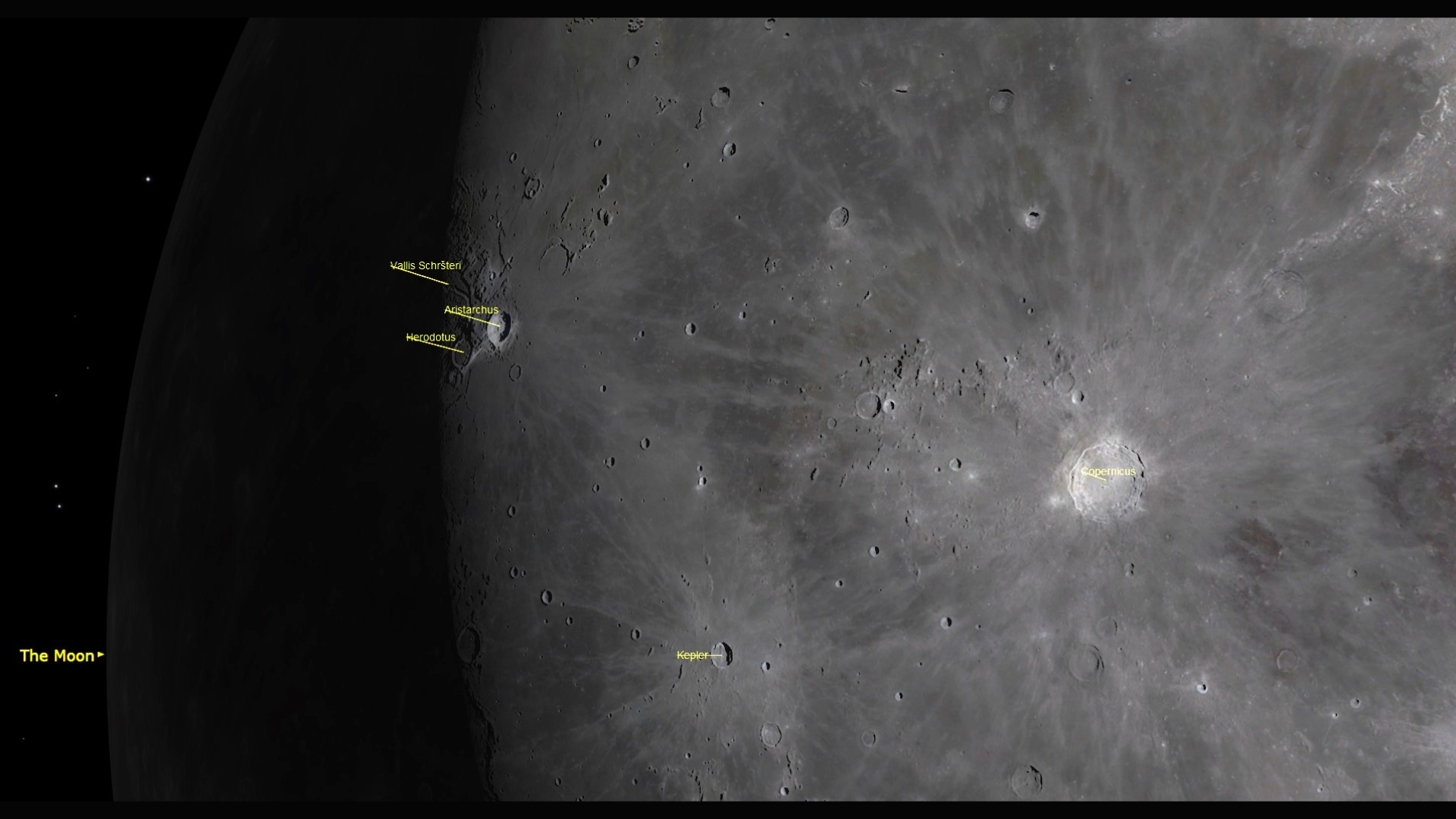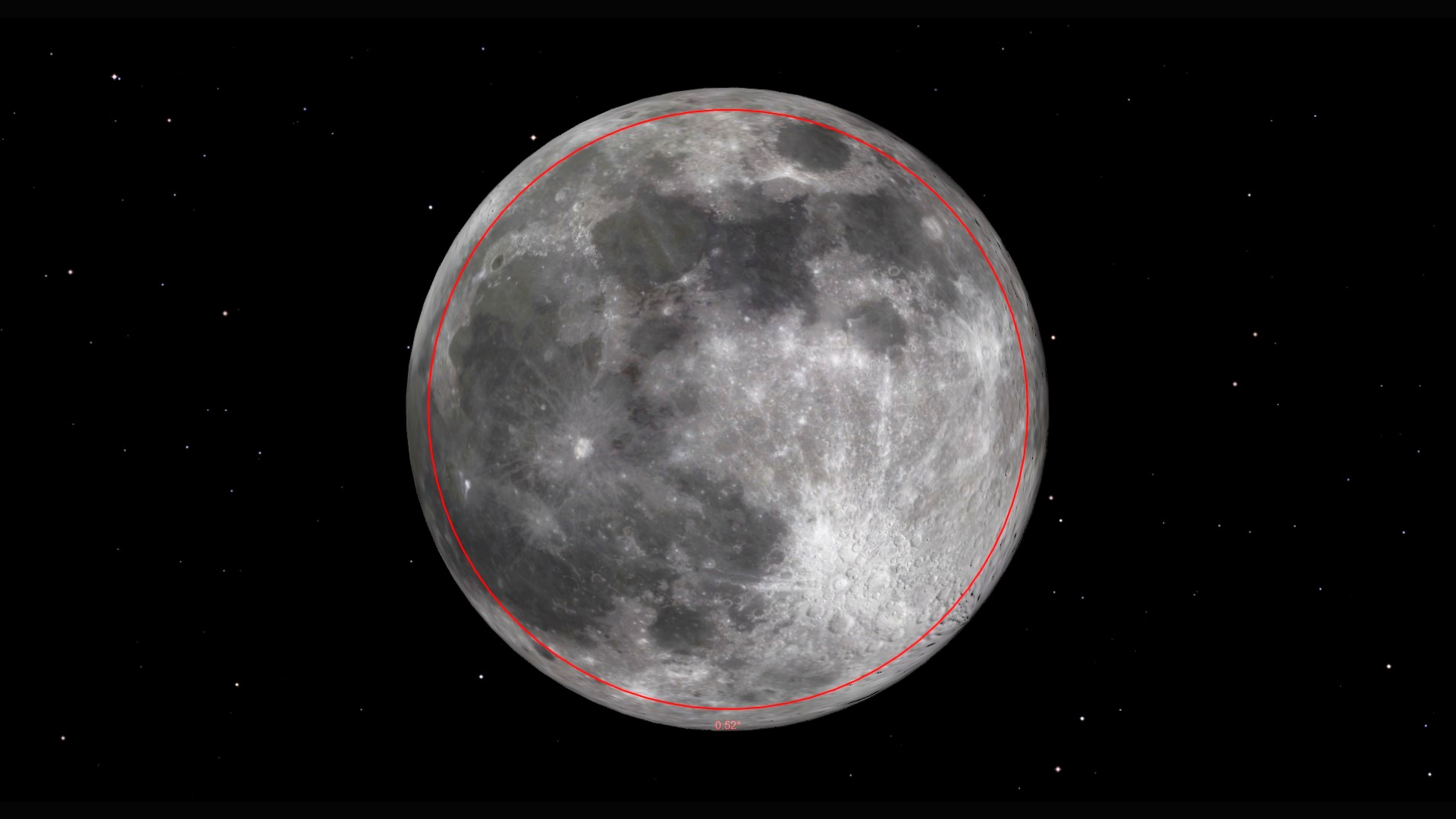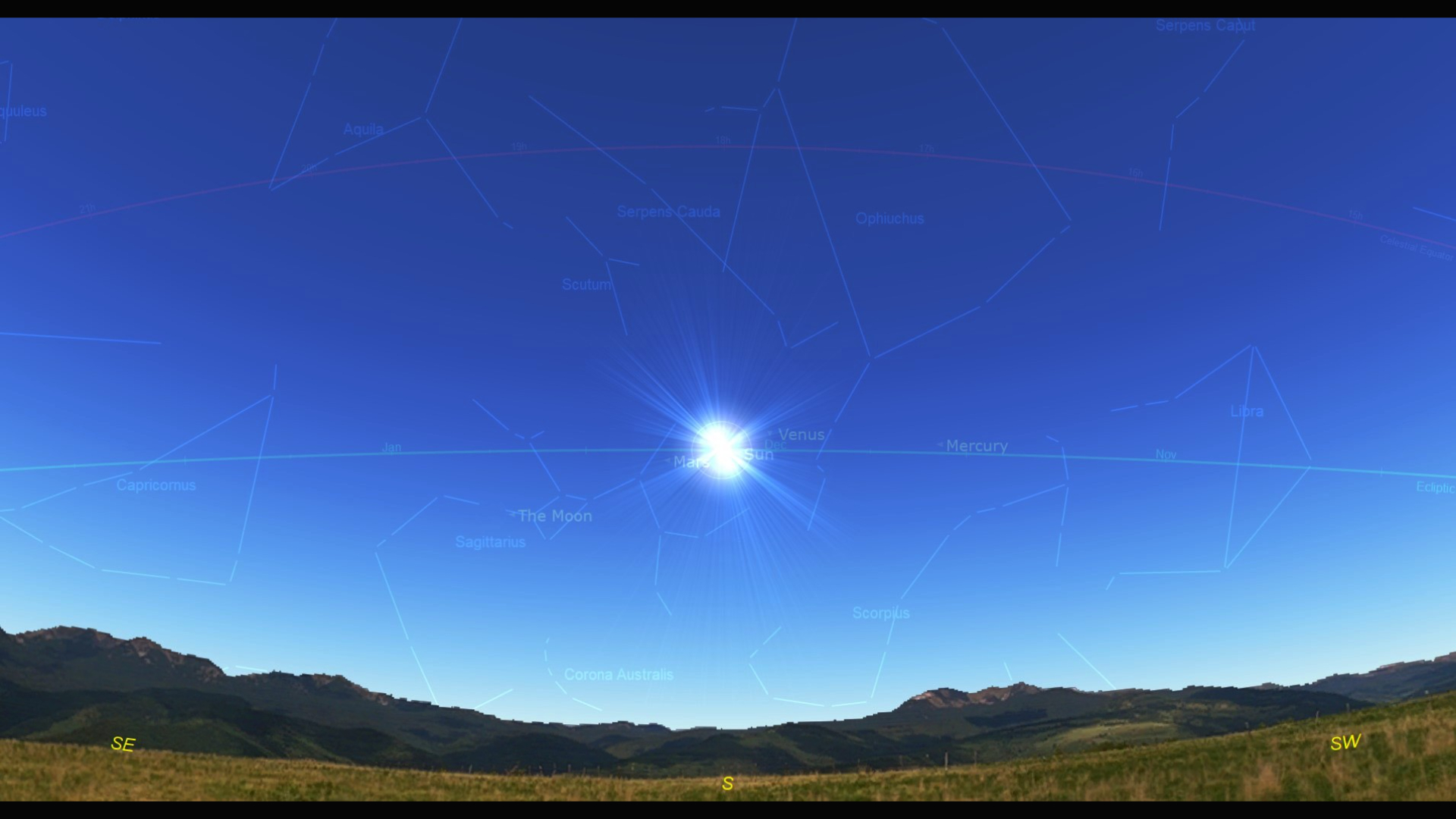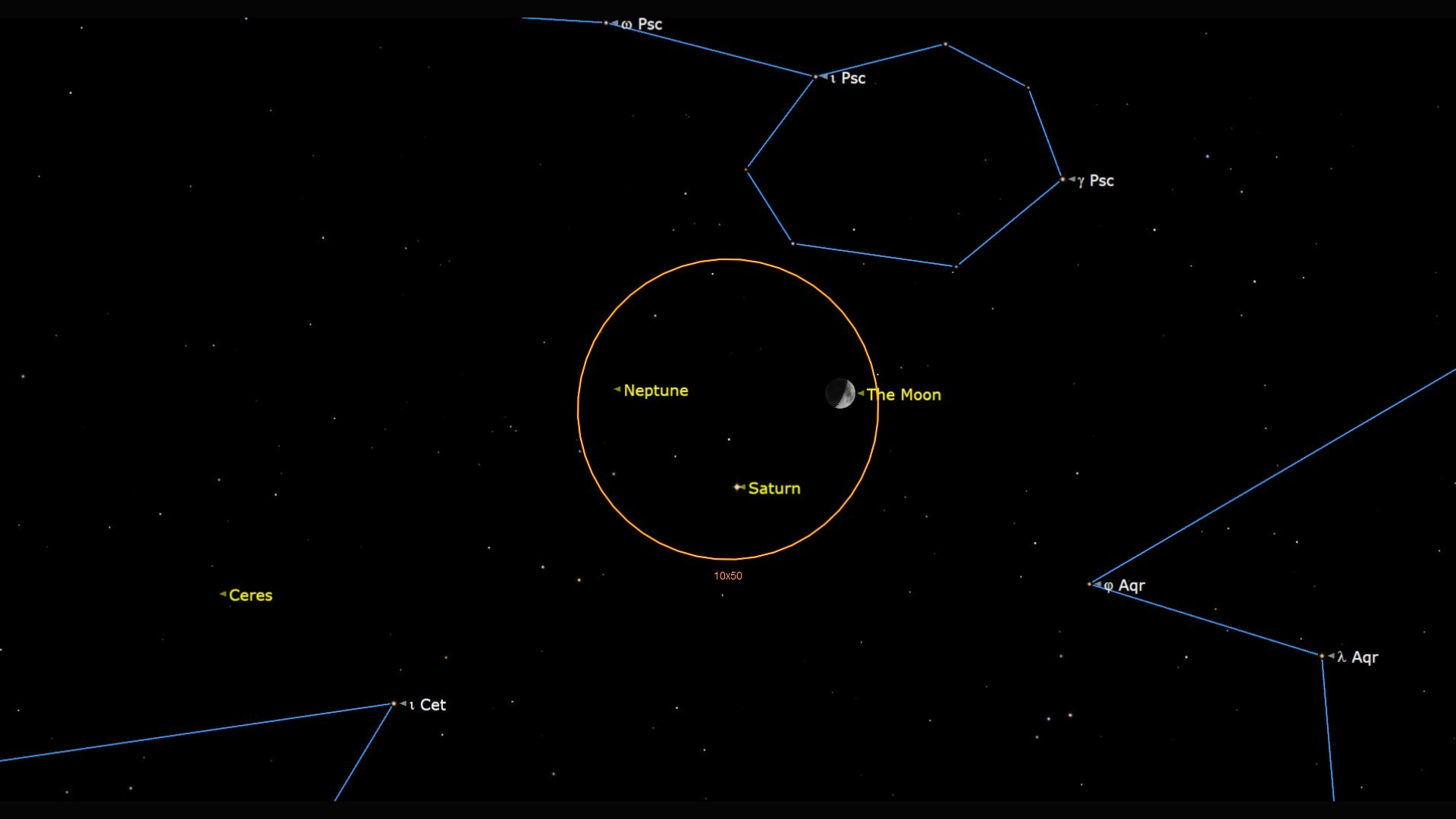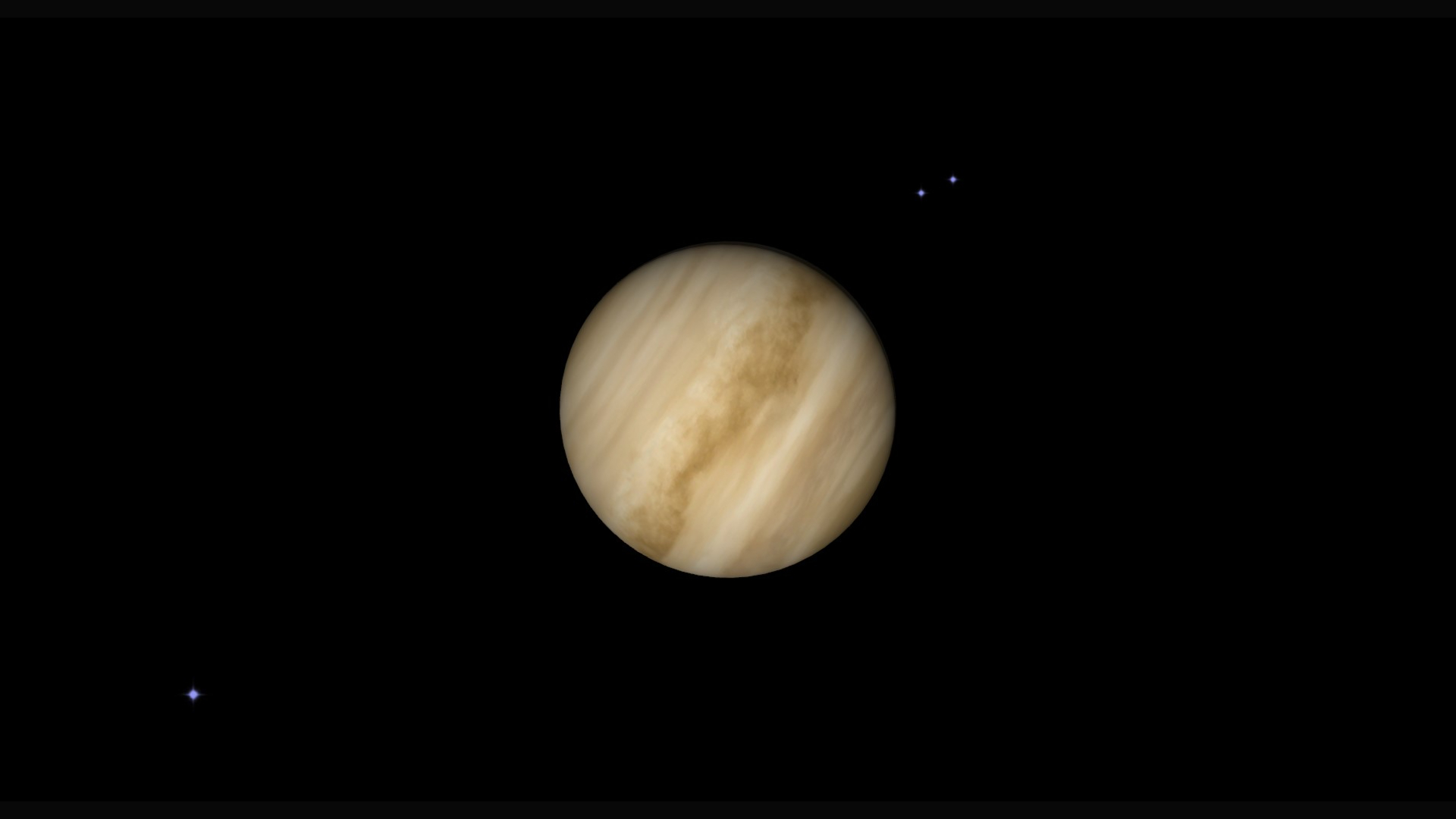Night sky, December 2025: What you can see tonight [maps]
Find out what's up in your night sky during December 2025 and how to see it in this Space.com stargazing guide.


Looking for a telescope for the next night sky event? We recommend the Celestron StarSense Explorer DX 130AZ as the top pick for basic astrophotography in our best beginner's telescope guide.
The night sky tonight and on any clear night offers an ever-changing display of fascinating objects you can see, from stars and constellations to bright planets, the moon, and sometimes special events like meteor showers.
Observing the night sky can be done with no special equipment, although a sky map can be very useful, and a good telescope or binoculars will enhance some experiences and bring some otherwise invisible objects into view.
You can also use astronomy accessories to make your observing easier, and use our Satellite Tracker page powered by N2YO.com to find out when and how to see the International Space Station and other satellites. We also have a helpful guide on how you can see and track a Starlink satellite train.
You can also capture the night sky by using any of the best cameras for astrophotography, along with a selection of the best lenses for astrophotography.
Read on to find out what's up in the night sky tonight (planets visible now, moon phases, observing highlights this month) plus other resources (skywatching terms, night sky observing tips and further reading)
Related: The brightest planets in the night sky: How to see them (and when)
Monthly skywatching information is provided to Space.com by Chris Vaughan of Starry Night Education, the leader in space science curriculum solutions. Follow Starry Night on Twitter @StarryNightEdu and Chris at @Astrogeoguy
Breaking space news, the latest updates on rocket launches, skywatching events and more!
Editor's note: If you have an amazing skywatching photo and would like to share it with Space.com's readers, send your photo(s), comments, and your name and location to spacephotos@space.com.
Calendar of observing highlights
Monday, Dec. 1 - The Aristarchus Plateau (all night)
Three prominent craters break up the expanse of Oceanus Procellarum, the widespread dark region on the moon's left-hand side. Large Copernicus is the easternmost of the craters. Its extensive, ragged ray system intermingles with that of the smaller crater Kepler to its southwest. The small, but very bright crater Aristarchus, positioned northwest of them, will fall just to the sunny side of the terminator on Monday, Dec. 1. Aristarchus occupies the southeastern corner of a spectacular, diamond-shaped plateau. A backyard telescope under high magnification will show features like the large, sinuous rille named Vallis Schröteri. Its snake-like form begins between Aristarchus and the next-door crater Herodotus and meanders across the plateau. One of the most colorful regions on the moon, NASA orbiters have detected high levels of radioactive radon there.
Wednesday, Dec. 3 - Bright moon crosses the Pleiades (evening)
On Wednesday evening, Dec. 3, skywatchers in North America and Europe can watch the orbital motion (green line) of the bright, nearly full moon carry it through the bright stars of the Pleiades star cluster, which is also known as Messier 45, Subaru, and the Seven Sisters. While the glare of the moon will hide the cluster's stars from your unaided eyes during the night, viewing the encounter during evening twilight, especially through binoculars (orange circle) or a backyard telescope, will allow you to see the moon passing among them. The blue nebulosity around the Pleiades stars is only apparent with a very large telescope or a long exposure image.
Thursday, Dec. 4 - Full Cold Supermoon
The December full moon will occur on Thursday, Dec. 4 at 6:14 p.m. EST, 3:14 p.m. PST, or 23:14 GMT. Traditionally known as the Oak Moon, Cold Moon, and Long Nights Moon, it always shines in or near the stars of Taurus and Gemini. The Ojibwe of the Great Lakes region call the December full moon Manidoo Giizisoons, the "Little Spirit Moon". For them, it is a time of purification and of healing of all Creation. Since full moons are always opposite the sun, they are fully illuminated and rise at sunset and set at sunrise. Full moons during the winter months reach as high in the sky at midnight as the summer noonday sun, and cast similar shadows. This full moon will occur only 12 hours after perigee, producing high tides and making it the third of three consecutive supermoons, appearing about 8% larger and 16% brighter than an average full moon (as shown by the red circle).
Friday, Dec. 5 - Full moon covers the Bull's Horn
On Friday, Dec. 5 in the Americas, the nearly full moon will shine all night long, surrounded by the constellations of Orion, Gemini, Auriga, and Taurus. Hours earlier, observers located in a zone encompassing northwestern Australia and southern Sumatra and extending eastward across Indonesia, the southern Philippines, Papua New Guinea, and over to Fiji can watch the moon occult Elnath (or Beta Tauri), the bright star that marks both the northern horn tip of Taurus, the Bull and the southern tip of Auriga's ring-like shape. Lunar occultations are perfectly safe to view with unaided eyes and through binoculars and telescopes. The time that the moon first covers Elnath and the duration of the occultation varies by location, so use an app like Starry Night or Sky Safari to look up the occultation timings for your location and be sure to start watching a few minutes ahead of time. In Port Moresby, Papua New Guinea the occultation will commence at 11:35 p.m. PGT and end at 12:48 a.m. PGT, which converts to 14:05 to 15:18 GMT for other time zones.
Saturday, Dec. 6 - Bright moon joins Jupiter in Gemini (all night)
In the eastern sky on Saturday evening, Dec. 6, the bright, waning gibbous moon will shine in central Gemini above the brilliant planet Jupiter. The moon and Jupiter will cross the sky all night long while the moon's orbital motion carries it directly towards Gemini's brightest star Pollux. In the western sky before dawn on Sunday morning, the moon will be tucked underneath a broad arch composed of the very bright star Procyon, Jupiter, Pollux and Castor, Capella, and Mirfak, making a spectacular visual and photo opportunity.
Sunday, Dec. 7 - Mercury at Greatest Western Elongation (predawn)
On the mornings surrounding Sunday, Dec. 7, Mercury will reach its widest angle of 21° west of the sun, and peak visibility, for its current morning apparition. Starting around 6 a.m. in your local time zone, look for the planet shining very low in the southeastern sky, and climbing until sunrise hides it. In a telescope (inset) Mercury will exhibit a 61%-illuminated, waxing gibbous phase. Mercury's position above the morning ecliptic (green line) will make this a good apparition for mid-northern latitude observers, but a poor showing for those located south of the equator. The planet will continue to be well-placed for viewing for almost two weeks after greatest elongation. Turn all optical aids away from the eastern horizon before the sun rises.
Monday, Dec. 8 - Bright moon buzzes the Beehive (predawn)
In the southwestern sky before dawn on Monday morning, Dec. 8 in the Americas, the bright, waning gibbous moon will shine several finger widths to the right (or about 3 degrees to the celestial northwest) of the large open star cluster in Cancer known as the Beehive, Praesepe, and Messier 44. The moon and the stellar "bees", which will be scattered across an area more than twice the size of a full moon, will fit into the field of view in binoculars (orange circle). Observers located in more westerly time zones will see the moon even closer to the cluster. The stars will be more visible if you hide the bright moon beyond the edge of the binoculars' field of view.
Tuesday, Dec. 9 - Gibbous moon covers Regulus (overnight)
When the waning gibbous moon clears the rooftops in the east late on Tuesday night, Dec. 9, Leo's brightest star, blue-white Regulus, will be twinkling just below it. The duo will cross the sky together all night long. Meanwhile, the moon's eastward orbital motion by its own diameter every hour will produce an occultation of Regulus that will be visible across northern and eastern Canada, Greenland, Iceland, and during dawn twilight for the United Kingdom and Scandinavia. In Edmonton, Alberta, the leading, lit portion of the moon will cover Regulus at 10:59 p.m. MST. The star will emerge from behind the moon's dark limb at 11:30 p.m. MST. Lunar occultations are perfectly safe to view with unaided eyes and through binoculars and telescopes. The timing varies by location, so use an app like Starry Night or Sky Safari to look up the occultation timings for your location and be sure to start watching a few minutes ahead of time.
Thursday, Dec. 11 - Third quarter moon
The moon will complete three quarters of its orbit around Earth, measured from the previous new moon, on Thursday, Dec. 11 at 3:52 p.m. EST, 12:52 p.m. PST, or 20:52 GMT. At its third (or last) quarter phase the moon is half-illuminated, on its western, sunward side. It will rise around midnight local time, and then remain visible until it sets in the western daytime sky during the early afternoon. Third quarter moons are positioned ahead of the Earth in our trip around the sun. About 3½ hours later, Earth will occupy that same location in space. The week of dark, moonless evenings that follow this phase are ideal for observing the fainter objects in the night sky.
Friday, Dec. 12 - Stellar halo around Mirfak (all night)
On mid-December evenings, the constellation of Perseus is climbing the northeastern sky. The outer rim of our Milky Way galaxy runs through Perseus' stars, filling its territory with rich star clusters. The largest of them surrounds his brightest star, Mirfak, or Alpha Persei. That elderly yellow supergiant star has evolved out of its blue phase and is now fusing helium into carbon and oxygen in its core. Melotte 20, also known as the Alpha Persei Moving Group and the Perseus OB3 Association, is a collection of 100 or so young, massive, hot B- and A-class stars sprinkled over several finger widths (or 3 degrees) of the sky around Mirfak. The cluster can be seen with unaided eyes, but it's especially dazzling in binoculars (orange circle). Its stars are approximately 600 light-years from the sun and are moving as a group - Mirfak along with them.
Sunday, Dec. 14 - Geminids Meteor Shower peaks (overnight)
The Geminids, one of the most spectacular meteor showers of the year, is active from Nov. 19 to Dec. 24 annually while Earth passes through the cloud of sand-sized grains dropped by the asteroid designated 3200 Phaethon. The number of Geminid meteors will gradually ramp up to a peak in the wee hours of Sunday morning, Dec. 14, in the Americas, and then decline rapidly on the following nights. Geminid meteors are often bright, intensely colored, and slower-moving than average. Expect to see a good number of Geminid meteors beginning after dark on Saturday evening and upwards of 120 meteors per hour around 2 a.m. local time on Sunday - the time when the sky overhead will be pointing toward the densest part of the debris field. True Geminids will appear to streak away from the shower's radiant near Gemini's bright stars Castor and Pollux and brilliant Jupiter, but the meteors can appear anywhere in the sky, so just keep looking up and around. Light from the 26%-illuminated, waning crescent moon may slightly affect the number of meteors after it rises during the wee hours.
Sunday, Dec. 14 - Pretty crescent poses near Spica (predawn)
In the eastern sky before dawn on Sunday morning, Dec. 14, the pretty, waning crescent moon will be a short distance to the right (or celestial south) of Virgo's brightest star, Spica. The duo will be cozy enough to share the view in binoculars (orange circle). The bright dot of Mercury will climb high enough to join them after about 6 a.m. local time.
Wednesday, Dec. 17 - Watch Algol fade
Algol, also designated Beta Persei, is among the most easily observed variable stars for skywatchers. During a ten-hour period that repeats every 2 days, 20 hours, and 49 minutes, Algol's visual brightness dims and re-brightens noticeably when a companion star orbiting nearly edge-on to Earth crosses in front of the much brighter main star, reducing the total light output we receive. Algol normally shines at magnitude 2.1, similar to the nearby star Almach (aka Gamma Andromedae). But when fully dimmed, Algol's brightness of magnitude 3.4 is almost identical to Rho Persei (or Gorgonea Tertia or ρ Per), the star that sits just two finger widths to Algol's lower right (or 2.25 degrees to the celestial south). Around 5:27 p.m. EST on Wednesday evening, Dec. 17, Algol will commence one of its drops in brightness. At that time, it will be shining about halfway up the eastern sky. When Algol reduces to its minimum intensity five hours later, at 10:27 p.m. EST, it will be located almost overhead in the western sky. Algol's variations are best seen with unaided eyes and binoculars, which allow you to see its comparison stars at the same time.
Thursday, Dec. 18 - Sliver of moon near Antares and Mercury (before sunrise)
Above the southeastern horizon before sunrise on Thursday morning, Dec. 18, the extremely thin crescent of the old, waning moon will shine just to the lower right (or celestial south) of Antares, the red giant star that marks the heart of Scorpius — close enough to share the view in binoculars (orange circle). The duo will be higher in the sky and easier to see from tropical latitudes on Earth. Mercury will shine a palm's width to the upper left (or 6 degrees to the celestial north) of Antares.
Saturday, Dec. 20 - Micro new moon
The moon will reach its new phase on Saturday, Dec. 20 at 01:43 GMT, which converts to Friday, Dec. 19 at 8:43 p.m. EST and 5:43 PST. At that time, our natural satellite will be located within Sagittarius and 5 degrees south of the sun. While it's new, the moon is travelling between Earth and the sun. Since sunlight can only reach the far side of the moon, and the moon is in the same region of the sky as the sun, the moon becomes unobservable from anywhere on Earth for about a day (except during a solar eclipse). This new moon will occur less than 3 days after apogee, making it a micro new moon. On the evenings following the new moon phase, Earth's planetary partner will return to shine in the western sky after sunset.
Sunday, Dec. 21 - Northern winter solstice
Winter in the Northern Hemisphere will officially commence in the Americas on Sunday, Dec. 21, at 10:03 a.m. EST and 7:03 a.m. PST, or 15:03 GMT. At the solstice, the sun will attain its southernmost declination for the year, resulting in the lowest elevation in the sky of the noonday sun, the least amount of solar insolation, and the shortest amount of daylight of the year. Conversely, the Southern Hemisphere will see its highest sun and maximum daylight hours for the year. After the December solstice, the amount of daylight time will begin to increase for the Northern Hemisphere.
Monday, Dec. 22 - Ursids Meteor Shower peaks (predawn)
The Ursids meteor shower, which is produced by particles of debris dropped by the periodic comet 8P/Tuttle, runs from Dec. 17 to 26 every year. The weak, short-duration shower will peak (usually with only 5 to 10 meteors visible in an hour) while Earth is traversing the densest part of the debris field in mid-morning on Monday, Dec. 22 in the Americas, so the best time to watch for Ursid meteors will be before dawn. True Ursids will streak away from the shower's radiant, located between the North Star Polaris and the Big Dipper's handle, but the meteors can appear anywhere in the sky.
Wednesday, Dec. 24 - Two shadows and moons cross Jupiter
From time to time, observers with good quality telescopes can watch the small, round, black shadows of the Galilean moons traverse Jupiter's disk. On Wednesday night, Dec. 24 and into Thursday morning, sky-watchers located in Asia and Oceania can watch two of the shadows crossing the southern hemisphere of Jupiter together for about 17 minutes. At 11:31 p.m. Indochina Time (or 16:31 GMT), the small shadow of Io will join the much larger shadow of Callisto, which began its own passage across the planet's southern polar zone at 8:05 p.m. ICT (or 13:05 GMT). Callisto's shadow will leave Jupiter at 11:48 p.m. ICT (or 16:48 GMT), leaving Io's shadow to continue on alone until 1:48 a.m. ICT (or 18:48 GMT). Watch for Io and Callisto themselves to move onto Jupiter's disk by 11:55 p.m. ICT.
Thursday, Dec. 25 - A Christmas star (late evening)
Sirius, the brightest star in Canis Major and in the entire night sky, too, is hard to miss once it clears the trees and rooftops in the southeast by 7:30 p.m. local time. Also known as the Dog Star, it will climb to its highest point in the lower part of the southern sky shortly after midnight local time. If you are walking through your darkened house in the middle of the night, Sirius might catch your eye out a window because it never climbs very high. Sirius is a hot, blue-white, A-class star located only 8.6 light-years from our sun. Its extreme brightness and its low position in the sky combine to produce spectacular flashes of various colors as it twinkles. A very large telescope may allow you to see Sirius B, a faint white dwarf companion star located just 10 arc-seconds to the east of Sirius.
Friday, Dec. 26 - Half-moon meets Saturn and Neptune
As the sky darkens after sunset on Friday, Dec. 26, the prominent, creamy-yellow dot of Saturn will appear several finger widths to the moon's lower left (or 3 degrees to its celestial southeast) about halfway up the southern sky. Once the sky is fully dark, the faint, blue speck of Neptune will join the party. All three objects will share the view in binoculars (orange circle) as they descend in the southwest all evening, but Neptune will be more easily seen if you hide the bright moon just beyond the right edge of the binoculars' field of view. Ceres, the largest object in the main asteroid belt, will be positioned to Saturn's lower left (or celestial southeast).
Friday, Dec. 26 - The Lunar X
Several times a year, for a few hours near the moon's first quarter phase, patterns on the moon called the Lunar X and Lunar V become visible in strong binoculars and backyard telescopes (inset). The Lunar X is located on the terminator south of the crater La Caille, about one third of the way up from the southern pole of the moon (at 2° East, 24° South). The "V" is located near the crater Ukert (at 1° East, 14° North). On Friday, Dec. 26, those letter shapes are predicted to start developing by 8 p.m. EST (or 01:00 GMT on Saturday), peak in intensity around 9:30 p.m. EST (or 02:30 GMT), and then gradually fade out. The Lunar X and V will be observable anywhere on Earth where the moon is visible, especially in a dark sky, between those hours.
Saturday, Dec. 27 - First Quarter moon
The moon will complete the first quarter of its 29.53-day trip around Earth on Saturday, Dec. 27 at 2:10 p.m. EST, 9:10 a.m. PST, and 19:10 GMT. At first quarter, the moon's 90-degree angle from the sun causes us to see it half-illuminated on its eastern side among the faint stars of Pisces. First quarter moons always rise around midday and set around midnight, so they are also visible in the afternoon daytime sky. The evenings surrounding first quarter are the best ones for seeing the lunar terrain when it is dramatically lit by low-angled sunlight, especially along the terminator, the pole-to-pole boundary that separates the moon's lit and dark hemispheres.
Monday, Dec. 29 - Crater Copernicus
For several nights starting on Monday, Dec. 29 conditions will be particularly good for viewing the prominent crater Copernicus, which is located in eastern Oceanus Procellarum, the broad dark region south of Mare Imbrium and slightly northwest of the moon's centre. Copernicus' 800-million-year-old impact scar is visible with unaided eyes and binoculars — but telescope views will reveal many more interesting aspects of lunar geology. Several nights before the moon reaches its full phase, Copernicus exhibits heavily terraced edges due to slumping, an extensive ejecta blanket outside the crater rim, a complex central peak, and both smooth and rough terrain on the crater's floor. Around full moon, Copernicus' ray system, extending 500 miles (800 km) in all directions, becomes prominent. Use high magnification to look around Copernicus for small craters with bright floors and black haloes - impacts through Copernicus' white ejecta that excavated dark Oceanus Procellarum basalt and even deeper highlands anorthosite.
Wednesday, Dec. 31 - Moon slips through Subaru
High in the western sky on Wednesday night, Dec. 31, the orbital motion (green line) of the bright, waxing gibbous moon will carry it through the bright Pleiades Star Cluster, which is also known as Subaru in Japan. This will be their second meeting this month, but the encounter will only be visible from northeastern Asia for about 2 hours centered on 11 p.m. Japan Standard Time or 14:00 GMT. In the Western Hemisphere, the moon will shine above Taurus' brightest star Aldebaran and nearly a fist's diameter to the left (or celestial east) of the cluster. The cluster is best viewed in binoculars (orange circle). The blue nebulosity around the Pleiades stars is only apparent with a very large telescope or a long exposure image.
Visible planets
Mercury
As December begins, Mercury will shine above the eastern horizon before sunrise, commencing its best morning apparition of 2025 for Northern Hemisphere observers, but a poor showing from mid-southern latitudes. On Dec. 7, it will reach its greatest angle from the sun of 21 degrees and easiest visibility — especially around 6 a.m. local time. The innermost planet will spend the rest of December dropping sunward through Libra until midmonth and then to the left (or celestial north) of Scorpius' stars. Its magnitude -0.5 speck will remain visible all month, though with increasing difficulty in the final week of December.
Viewed through a telescope, Mercury will display a waxing crescent phase until it reaches dichotomy on Dec. 4, and then a gibbous phase that grows to 95%-illuminated at month's end. Meanwhile, its apparent disk size will almost halve from 7.9 to 4.9 arc-seconds. The slim crescent of the old moon will shine a generous fist's diameter to Mercury's right (or celestial southwest) on Dec. 17 and then to the planet's lower right on the following morning.
Venus
Venus will be hidden while it approaches the morning sun during December. The brilliant planet will reappear in the western evening sky about a month after it passes superior solar conjunction on January 6.
Mars
Mars will be hidden in the western sky while it is carried toward the sun during December. The red planet will pass superior solar conjunction on January 9 and then start to emerge into the eastern morning sky during February.
Jupiter
As December begins, very bright Jupiter will clear the treetops in the east by mid-evening, culminate due south at 3 a.m. local time and then gleam in the western sky before sunrise. By month's end, the giant planet will rise shortly after sunset and be well-placed for observing all night long as it prepares for opposition night on January 10. During December, Jupiter will brighten slightly from an initial magnitude of -2.54 while it shifts daily upward (or celestial westward) toward the bright star Wasat in Gemini — forming an extra corner in the giant Winter Hexagon asterism. Binoculars will easily show Jupiter's four large Galilean moons flanking the planet. A backyard telescope will reveal its equatorial bands on a disk that grows from 44.3 to 46.5 arc-seconds during the month, while a better quality instrument will reveal the Great Red Spot every 2nd or 3rd night. Jupiter's Galilean satellites will be frequently eclipsed and occulted by the planet. From time to time, those moons will cast their round, black shadows on Jupiter, including a double shadow transit visible in parts of the world on Dec. 24. The bright, waning gibbous moon will create a lovely photo opportunity when it shines near Jupiter and Gemini's two brightest stars Castor and Pollux on Dec. 6 and 7.
Saturn
Saturn will be well-positioned for viewing during the early evening for all of December. Its prominent, creamy yellow dot will pop out of the twilight in the southern sky at dusk and set in the west around midnight local time — all the while outshining far fainter Neptune, which will be positioned several finger widths to its left (or 4 degrees to its celestial northeast), and the faint constellations of Aquarius, Pisces, and Cetus that surround the two planets. After completing its annual retrograde loop in late November, Saturn will gradually ramp up to its regular eastward prograde motion through northeastern Aquarius during December.
Viewed in a telescope, Saturn will show an apparent disk diameter of about 17.6 arc-seconds and its extraordinary rings will subtend 41 arc-seconds. The ring system will open up a little from a razor-thin tilt of 0.6° to 1.5°. Saturn's moons, with the exception of inclined Iapetus, will travel close to its ring plane and cast their tiny shadows onto the planet from time to time, with its largest satellite Titan alternatively passing in front of or behind Saturn's globe about every 8 nights. The waxing, almost half-full moon will shine several degrees above Saturn on Dec. 26.
Uranus
Fresh from opposition on November 21, Uranus will be well-placed for observing all night long during December, climbing the eastern sky positioned several finger widths to the lower right (or 4 degrees to the celestial south) of the bright Pleiades Cluster in Taurus, culminating due south around 10 p.m. local time, and then sinking into the trees during the wee hours. The magnitude 5.6 blue-green planet is visible in a backyard telescope and through binoculars on moonless nights. The very bright, waning gibbous moon will shine several finger widths above Uranus on Dec. 3 and then appear somewhat farther from the planet on Dec. 30-31.
Neptune
During December, the distant, magnitude 7.9 planet Neptune will continue to lurk several finger widths to the upper left (or about 4 degrees to the celestial northeast) of much brighter Saturn. The paired planets will be in the southern sky after dusk and then sink into the west around midnight local time. On Dec. 11, Neptune will complete a retrograde loop that it began in July, and then it will gradually resume its eastward prograde motion through southwestern Pisces. In a backyard telescope, Neptune's 2.3 arc-seconds disk will resemble a dull blue star.

Chris Vaughan, aka @astrogeoguy, is an award-winning astronomer and Earth scientist with Astrogeo.ca, based near Toronto, Canada. He is a member of the Royal Astronomical Society of Canada and hosts their Insider's Guide to the Galaxy webcasts on YouTube. An avid visual astronomer, Chris operates the historic 74˝ telescope at the David Dunlap Observatory. He frequently organizes local star parties and solar astronomy sessions, and regularly delivers presentations about astronomy and Earth and planetary science, to students and the public in his Digital Starlab portable planetarium. His weekly Astronomy Skylights blog at www.AstroGeo.ca is enjoyed by readers worldwide. He is a regular contributor to SkyNews magazine, writes the monthly Night Sky Calendar for Space.com in cooperation with Simulation Curriculum, the creators of Starry Night and SkySafari, and content for several popular astronomy apps. His book "110 Things to See with a Telescope", was released in 2021.
You must confirm your public display name before commenting
Please logout and then login again, you will then be prompted to enter your display name.

